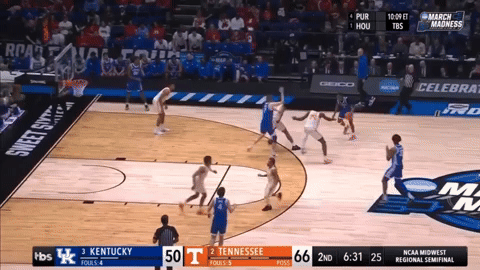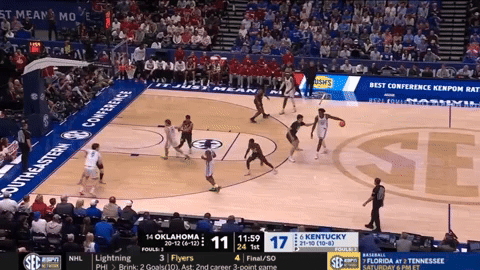Amari Williams Film Study Part 1: Passing
Starting to look at the Boston Celtics latest big man addition
The NBA Draft is in the books. Brad Stevens pulled his usual magic act during the second round, somehow turning the 32nd pick into the 46th and 57th picks along with a 2026 second-rounder and a 2027 second-rounder.
How he managed to turn one pick into four is something that needs to be studied.
After two days of the draft, Boston walks away with Hugo Gonzalez (28th), Amari Williams (46th) and Max Shulga (57th). There is very little publicly available footage and statistics on Gonzalez. You need access to proprietary data that is primarily accessed by European teams. So, we may need to wait until Summer League for a full deep dive here on the Celtics Chronicle.
Fortunately, I do know of a film breakdown coming out on CelticsBlog later today, from another European writer who does have access to that data and footage, so keep your eyes peeled over there.
So, with Gonzalez off the board and all the time in the world to dive into Anfernee Simons and Georges Niang, I wanted to spend today diving into Amari Williams.
Over the next two breakdowns, we'll dive deep into what makes Williams intriguing as a second-round pick, starting today with his most unique skill: playmaking.
Let’s get to it.
The Basics
Williams is a 7-foot, 23-year-old big man. He’s a five-year collegiate product, having spent four seasons with Drexel in the CAA before moving to Kentucky for his final season. During his maiden year in the SEC, Williams averaged 10.9 points, 8.5 rebounds and 3.2 assists.
Despite having an impressive perimeter game, he doesn’t shoot many threes. He’s averaged 0.2 attempts per game throughout his 141-game college career. So, don’t expect him to be filling a Kristaps Porzingis-style role at any point soon — if at all.
Instead, I see Williams being a blend of Luke Kornet and Neemias Queta. He’s got the size and finishing ability to be a rim-runner, but has the patience, screening and passing skills to thrive as a non-shooting big in a five-out offense.
That passing ability is where our film study begins.
1. Passing Ability
Williams displayed an interesting range of passing throughout his collegiate career. He can thrive on the perimeter in delay1 actions, operating out of the post, or at the nail2. Williams also showed control and court vision when attacking the rim, often finding cutters for last-second dump-off passes — the type you would expect from wings or guards.
One of the most popular perimeter-based actions out of the delay is known as a Zoom action.3
Williams has no problem running Zoom sets. His patience on the rock ensures that he’s usually in the right position, and he’s more than willing to flow straight into a screen, which creates the necessary separation for the hand-off receiver.
In this instance, Koby Brea comes off the hand-off to sink a nail pull-up. Yet, despite Williams’ patience with the hand-off, it’s his screen that shines in the above action. Blending his passing and screening in this way is exactly how he’ll thrive at the NBA level.
Talking of patience, check out this assist against LSU. Williams has the rock at the nail. Rather than rushing to get the ball out of his hands, he takes his time to survey the floor.
Williams recognizes that the screen receiver has been picked up on the switch. Therefore, initiating the hand-off wouldn’t create a scoring advantage. So, he denies the hand-off and waits for the cutter to continue his run.
As the cutter comes over the DHO and gets into the paint, Williams uses the threat of the cut to punish the low man, who is cheating off the corner to provide rim resistance if Williams fires the rock into the paint. The punishment comes by using the cut as a decoy to find the open shooter on the corner, leading to a lightly contested catch-and-shoot three.
Young bigs aren’t usually this poised when looking to create for others. They want the rock out of their hands quickly, so they can screen, roll or post-up. The fact that Williams is so comfortable operating as a creation hub is an exciting wrinkle to his skill set.
Outside of his patience, Williams really shines when feeding cutters, especially if they’re face-cutting or back-cutting their defender. Check the above clip. Williams is once again in a delay set, surveying the floor and waiting for something to unfold. Once the cut occurs, Williams rewards the cutter with the high pocket-pass, which is something Jayson Tatum mastered with Derrick White last season.
He can get fancy with it, too…
Williams can also tie all of this together to create for others in motion. He can come off a screen, get the rock, find a cutter or someone relocating, wait for the passing lane to open and then make the read with ease. Take the blow clip as a solid example.
Williams comes off a screen, flows into a high post-up with his back to the basket, and waits for the weakside action to unfold before finding his man in the paint with an easy one-handed pass. These actions are hard to defend, because Williams is capable of facing up and attacking off the bounce, so his defender can’t help off to deny the lane or double the pass receiver.
If his defender opens a driving lane, Williams will call his own number and create out of how the defense reacts, like in this clip…
The last aspect of his passing that I want to highlight is his “over the top4” passing.
Williams’ size makes it easy for him to see over the top of his defender when on the perimeter. Therefore, he sees actions unfolding easier than most, and has the processing speed, size, and touch to fire in passes over the top of his defender’s head. How that translates in the NBA, where players are bigger, quicker, smarter, and communication is at a premium, will remain to be seen, though…
Williams' playmaking ability is genuinely rare for a second-round big man. His patience, court vision, and willingness to operate as a creation hub could carve open opportunities within Mazzulla’s five-out system — assuming he isn’t sent straight down to Maine for the upcoming campaign.
Still, playmaking is just one piece of the puzzle. In Part 2, we'll examine Williams' post-up game, transition offense, and defensive potential to get a clearer picture of Boston’s latest big man.
A delay action is where the big man has the rock in his hands above the three-point line, as part of a five-out offense. This usually occurs above the break, but can happen anywhere around the horn.
The nail is a spot in the middle of the free-throw line. It’s called the nail because there is literally a nail in the floor.
A Zoom action is where the big has the rock in the delay. A pin-down is then set for a shooter in the corner. The shooter comes off the pin-down and curls into a dribble hand-off from the big man. This opens up drives, perimeter shots, and spray offense, among other options such as post-ups, etc.
Passing over the top of a defender.











